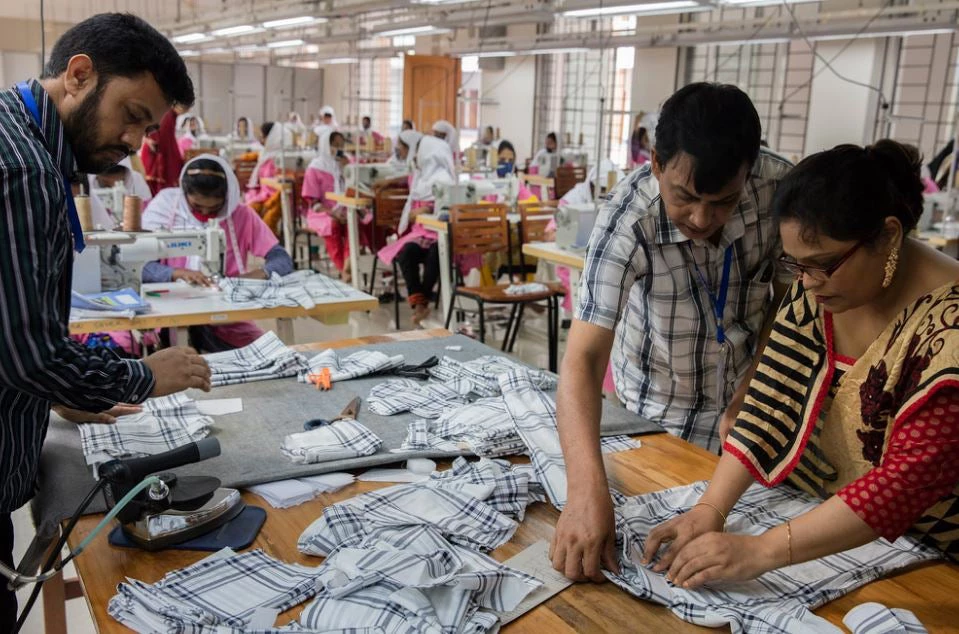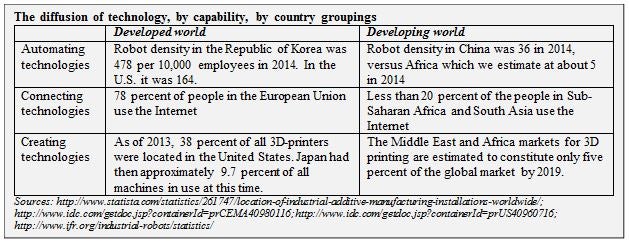
There is much speculation about what share of jobs might be automated by increasingly smart machines. One estimate suggests that countries such as the U.S. would see almost half of today’s jobs disappearing, while another estimate suggests that this might be just about one in ten jobs. But less is known about who will lose their jobs due to these transitions. And more critically, what might happen to the bottom 40 percent of the population of emerging countries that have only recently been exposed to basic digital technologies? Will they gain from technological progress, or will they face the negative effects of both exclusion and of others—countries or the better off—pulling ahead?
It is tempting to think of robots and artificial intelligence taking over, but even mature technologies such as mobile phones or Internet connectivity are only partly diffused (and at varying quality) across the world. As late as 2014, one hundred and forty-five countries had less than half of their population using the Internet. Hence, emerging economies could experience a future of work where the opportunities are constrained due to limited technological adoption by employers and workers. But the risks are out sized due to technology access and skills divides when compared to the advanced economies, weaker enabling environments, and different labor market characteristics. Put another way, the risk of deepening inequality across and within countries is significant.
Levels of technology access and skills in the emerging countries often lag the advanced economies. The table below illustrates the divides for different types of technologies across different country types. It shows that while technology will shape the labor market through similar channels in emerging economies as in the advanced economies, the extent and intensity of effects will differ.
Divergences exist within individual countries as well. Typically, major cities and towns are online, but most rural or remote communities are not, or face higher prices or poorer quality services. Divisions also exist across different demographic groups. Women, people with disabilities, social and ethnic minorities, and older people lack the same level of access to digital technology.
The people who are part of the poorest and most vulnerable groups—the bottom 40 percent in terms of income distribution—are the least likely to benefit from these technologies. Coincidentally, these are the very groups that would likely benefit the most from being able to use these tools. Similarly, many businesses in rural areas cannot access these technologies.
This means there is inequality in productivity, incomes, and opportunities for good job creation. And if the speculation about job losses due to digitization do play out, then the concern for policymakers will be about how to create new channels for income generation and inclusion, especially for the poorest.
Policies to make the future of work more inclusive and equitable
Public policies could position countries better to overcome lags in digitization. They could shape how the costs of digitization can be managed, to counter inequality and mitigate the costs for the poorest. Doing so could make the future of work more inclusive and equitable.
For this, two sets of public strategies are needed. First, to address bottlenecks in technology access and to build the capabilities of businesses and individuals, especially the bottom 40. Second, the bottom 40 will need support through the transition. initial experiments suggest at least three possible policies. First, reform systems to protect multi-tasking and ‘gig’ workers in ways similar to traditional workers. Second, improve short-term support to better help people who lose their jobs or need transition assistance. Finally, longer-term (and more radical) solution may be needed to provide income support for when technological change might indeed end the demand for most forms of human labor.
On the positive side, technological change opens up possibilities for countries to leapfrog and adopt more advanced technologies such as biometric identification for social programs (as in India), or drones for medical delivery rather than by road (as in Rwanda). Even with these adoptions, emerging economies may miss new digital opportunities to participate meaningfully in global e-commerce. And if businesses in advanced economies upgrade, they could accelerate re-shoring, cutting off the possibility of emerging economies benefiting from the shifting of jobs or tasks in manufacturing or services. Without the traditional pathways for growth and job-creation in place—such as exports, manufacturing, and the transformation of agriculture to industrial activity—it is unclear where the jobs for the millions of young people across Asia and Africa will come from.
The challenge for society is not technological change per se but rather, the risk that some individuals—especially those in the bottom 40—might bear a disproportionate part of the costs of any transitions in skills demanded, or as the nature of work changes.
Follow the World Bank Jobs Group on Twitter @wbg_jobs


Join the Conversation